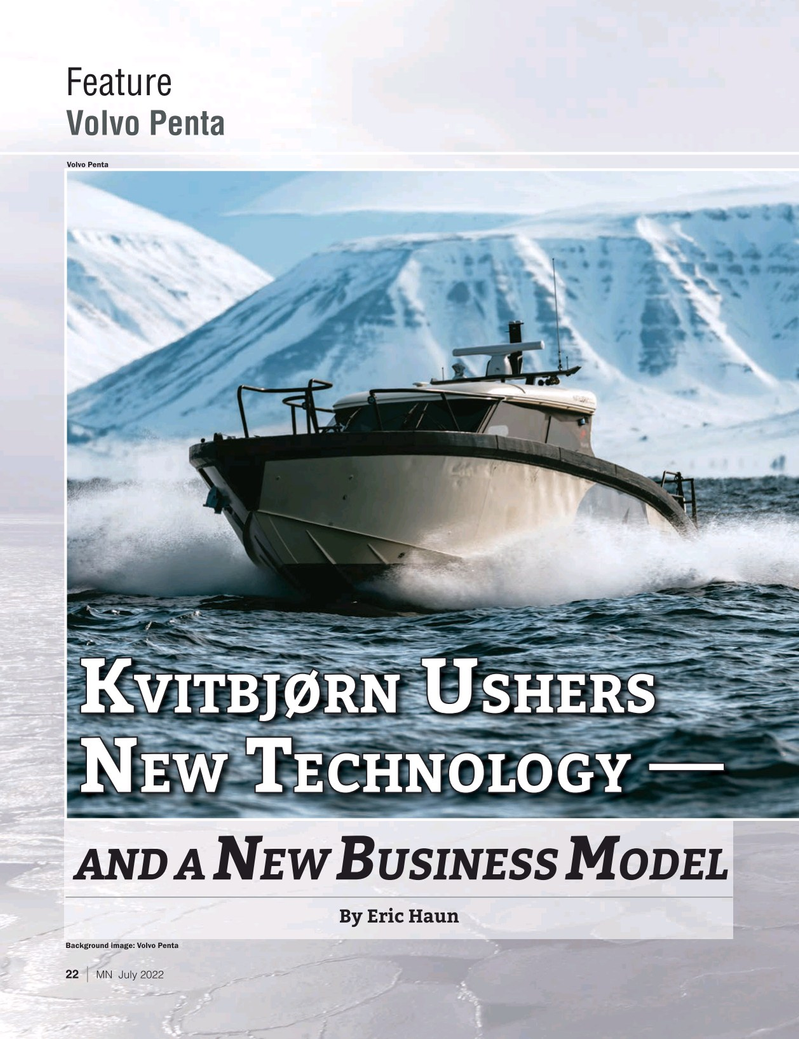
Page 22: of Marine News Magazine (July 2022)
Propulsion Technology
Read this page in Pdf, Flash or Html5 edition of July 2022 Marine News Magazine
ore Hoem, adventures director at Hurtigruten rounding environment.
Svalbard, has lived on Svalbard, the remote Nor- “It’s sort of a paradox to take guests out to a glacier front wegian archipelago just a few hundred miles with noisy engines running. That silence is maybe the from the North Pole, for more than two decades, coolest thing about this [vessel],” Hoem said. “Of course,
T long enough to witness the sea ice retreat signi? cantly and we go from A to B with some noise and diesel, but when more rain creep into the early and late snow season. we are at the destination it’s quiet. And that’s the key here,
These alarming effects of climate change are among key together with the sustainability part.” drivers behind the Hurtigruten Group’s sustainability ef- And while diesel-electric wasn’t the only option, it certain- forts, including a new hybrid-electric excursion vessel re- ly wasn’t the easiest either. It took a healthy dose of engineer- cently put into service in Longyearbyen, Svalbard’s largest ing to pull it off, Jonas Karnerfors, sales project manager at inhabited area. The 14.9-meter aluminum vessel, Kvitb- Volvo Penta, explained. Among key challenges were ? nding jørn, built by Marell Boats in Sweden, runs on a hybrid- a way to ? t the large, heavy batteries withing the Marell M15 electric propulsion system developed by Volvo Penta. hull. The team also had to come up with a way to heat the
Powered by a Volvo Penta twin D4-320 DPI Aquamatic batteries—rather than cool them, as is common in other en- hybrid solution, the boat has a top speed of 30-32 knots vironments—to ensure they maintain an optimal tempera- and a cruising speed of 24-25 knots, with a range of 500 ture withing the frigid Arctic waters, Karnerfors said.
nautical miles. Volvo Penta’s “helm to propeller” package for Kvitbjørn comes amid wider sustainability efforts being the vessel includes the engines and drivelines, the electronic led by both the Hurtigruten Group and Volvo Penta in paral- vessel control (EVC) system, joystick control, dynamic po- lel with tourism and marine industry peers striving to reduce sitioning system and the driver interface. The capacity of their environmental impacts. Increasingly, hybrid and elec- vessel’s lithium ion batteries is 100 kilowatt-hours (kWh). tric propulsion solutions are gaining interest among marine
Given the current state of technology, electri? cation is not operators working to slash emissions across various sectors.
an option for every vessel. One must consider the use case “Our vision as a company is to be a world leader in sus- to determine if a hybrid or full electric setup makes sense. tainable power solutions,” said Johan Inden, president of
For Kvitbjørn, which will be used for 3-4-hour sightseeing Volvo Penta’s marine business unit.
tours, batteries combined with diesel engines ? t the bill. Volvo Penta, as part of the Volvo Group, has committed
This wasn’t the only option, of course. According to to having a climate neutral impact by 2050. The company
Hoem, Hurtigruten had considered ordering a vessel with aims to offer a broader range of hybrid and full electric other propulsion arrangements such as more traditional products to the market by 2025, and Inden said Volvo outboard engines, but ultimately opted for Volvo Penta’s Penta sees 2030 as a “tipping point” for the uptake of green hybrid-electric solution based on its environmental advan- propulsion technologies in the marine industry.
tages, as well as the improved passenger experience. According to Inden, Volvo Penta’s “helm-to-propeller” ap-
Kvitbjørn’s tours out of Longyearbyen will provide an proach better positions the company to achieve its sustain- opportunity for up to 12 passengers to experience the ability goals by allowing it to have greater control over maxi- spectacular Arctic seascapes and landscapes, as well as Sval- mizing the vessel’s overall ef? ciency. “The platform that we’ve bard’s true residents: its natural wildlife, which includes developed is a combination of software systems, integration polar bears, reindeer, puf? ns, seals, walrus and whales. The between all the parts of the propulsion system with very effec- objective isn’t to cruise at 50-plus knots, it’s to give guests tive drives and propellers. It gives us a very unique position.” the best possible journey, Hoem explained. “The key to Inden said that the drive system in particular is often that, in many ways, is silence.” underestimated as a necessary piece of green propulsion
Kvitbjørn can be operated in three modes: full diesel, solutions. “The more effective you are getting your power diesel with electric assist or all-electric, the last of which in the water, the less of a footprint you’ll have,” he noted.
provides for a quieter ride that is much more pleasant As Kvitbjørn goes to work, Volvo Penta will analyze fuel for those on board and less disturbing to the pristine sur- savings and emissions reductions enabled by the hybrid- www.marinelink.com MN 23|

 21
21

 23
23
